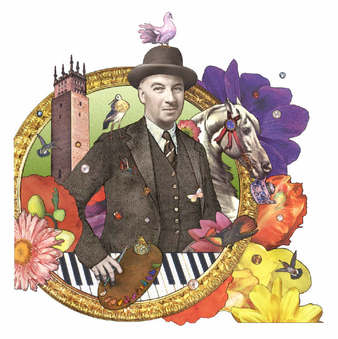FAB Faringdon Appreciation of Berners
Lord Berners, writer, artist and composer, lived at Faringdon House from the 1920s until his death in 1950. The FAB group ( associated with U3A). formed in 2013, are researching Berners works.
Contact Janet Deane for further information: [email protected]
Contact Janet Deane for further information: [email protected]
 Lord Berners by Nancy Tolford Lord Berners by Nancy Tolford
Lord Berners books include:
Fiction 1936 - The Camel 1937 - The Girls of Radcliff Hall 1941 - Far From the Madding War 1941 - Count Omega 1941 - Percy Wallingford and Mr. Pidger 1941 - The Romance of the Nose Non fiction 1922 - Lord Berners 1934 - First Childhood 1945 - A Distant Prospect |
Music by Lord Berners
Lord Berners wrote a variety of music genres; orchestra, wind ensembles, soloists, piano. Details can be found on the Chester Novello website Books about Lord Berners Lord Berners,The Last Eccentric Mark Amory Lord Berners. Composer, Writer,Painter Peter Dickinson |
Book Reviews by FAB group
Lord Berners Abroad
The Château de Résenlieu and Dresden
‘First Childhood’, by Lord Berners
This is Lord Berners’ first autobiographical book, written in 1941, and takes the reader from his early childhood memories up to his first four terms at Elmley.
‘A Distant Prospect’, by Lord Berners
This book is a sequel to his previous autobiography, ‘First Childhood’, and is similarly set out in short chapters. It takes the reader from the time Gerald (Lord Berners) left Elmley, his Preparatory School, through to his time at Eton. It is the late 1890’s and he is at the beginning of his teenage years (a phrase not yet invented).
Lord Berners Abroad
The Château de Résenlieu and Dresden
‘First Childhood’, by Lord Berners
This is Lord Berners’ first autobiographical book, written in 1941, and takes the reader from his early childhood memories up to his first four terms at Elmley.
‘A Distant Prospect’, by Lord Berners
This book is a sequel to his previous autobiography, ‘First Childhood’, and is similarly set out in short chapters. It takes the reader from the time Gerald (Lord Berners) left Elmley, his Preparatory School, through to his time at Eton. It is the late 1890’s and he is at the beginning of his teenage years (a phrase not yet invented).